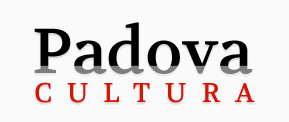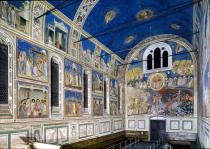Scrovegni Chapel
In 1300, a wealthy Paduan seigneur, Enrico Scrovegni, purchased the area of the Roman Arena in order to construct a sumptuous palace to be used as his residence, Next to this, he wished to build a chapel dedicated to the Blessed Virgin, in memory of the soul of his father Reginaldo, accused of being a usurer, and mentioned by Dante in Canto XVII of his Inferno. After having met Giotto, probably during the construction of the Basilica of St. Anthony, Scrovegni commissioned the Tuscan artist to decorate the Chapel. Giotto carried out this work between 1303 and 1305.
The frescoes of the Scrovegni Chapel cover the entire surface of the walls and ceiling of the building, and depict episodes in the lives of the Virgin Mary and Christ.
The vaulted ceiling is a blue star-spangled sky. The narration is depicted in three bands of frescoes on the walls and the triumphal arch. Starting from top right, the episodes recount the story of Joachim, followed by those of the Virgin Mary, Christ, the Passion of Christ and, lastly, Death and Resurrection. Under these is a basement of imitation marble, showing the Vices and Virtues.
On the wall above the entrance is the Day of Judgement: Christ the Judge is surrounded by the Angels and the Apostles. Below, to the right, are the Blessed; to the left, the Damned in their torment, depicted according to Medieval tradition.
Giotto used not only a new way of painting, but also retrieved ancient Roman techniques and, above all, applied particular technical devices which rendered the entire composition more realistic, radically renewing and ranging beyond the Byzantine tradition.
The wooden crucifix, which once completed the decoration of the Chapel, may today be admired in a hall of the City Museum. The altar holds statues by Giovanni Pisano.
Restorations
The Scrovegni Chapel was acquired by the city of Padova in 1880, and the vulnerable frescoes were repeatedly subjected to specialised restoration operations during the 19th and 20th centuries. From the 1970s until today, thanks to close collaboration between the city administration, cultural heritage authorities and the Istituto Centrale per il Restauro, the state of the building, the quality of the air in it, polluting factors, and the state of conservation of the frescoes themselves have all been carefully studied and monitored. The addition of the new access building, with its special air-conditioned waiting-room, means that even great numbers of visitors can enter the Chapel and admire Giotto masterpiece without jeopardising its already fragile condition in any way.
The state of the frescoes is now stable, and they have been restored further - delicate operations undertaken by the Istituto Centrale per il Restauro - thanks to an agreement between the city of Padova and the Italian Ministero per i Beni e le Attività Culturali.
Information:
City Museums
Piazza Eremitani 8, Padova
tel. +39 049 8204551
opening times: throughout the year: 09:00-19:00
Palazzo Zuckermann, Corso Garibaldi 33
tel. +39 049 8205664
opening times: throughout the year: 10:00-19:00
all Museums are closed on: Mondays (unless public holidays), January 1, May 1, December 25-26
the Scrovegni Chapel is open, even on Mondays.
Tickets: full price for all Museums, Scrovegni Chapel, Multimedial Room and Palazzo Zuckermann: 14.00 euro; Museums, Multimedial Room and Palazzo Zuckermann: 10.00 euro; children up to the age of 5 and disabled persons: free of charge.
N.B. Advance bookings are required to visit the Scrovegni Chapel: book on Telerete Nordest +39 049 2010020, Mon-Fri 09:00-19:00, Sat 09:00-18:00, or on-line: http://www.cappelladegliscrovegni.it.
All Entry tickets must be purchased from the City Museums office in Piazza Eremitani 8
How to reach City Museums and Palazzo Zuckermann:
from train station: buses nos. 3/ 10/ 12; on Sundays and public holidays: buses nos. 42; metrotram;
by car and coach: motorway exit Padova Est: Fairgrounds car park, shuttle bus service to centre of town
motorway exits Padova Sud and Padova Ovest: car park in ex-Foro Boario (Prato della Valle), shuttle bus service to centre of town; Via D. Valeri (off Via Trieste); Piazza Insurrezione (from 10.00, limited space).







